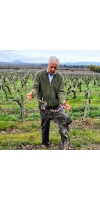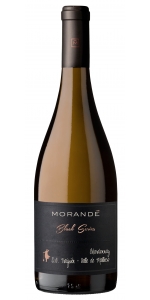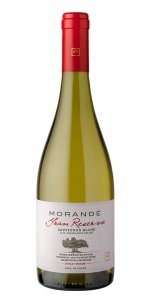Wine from Vina Morande

When Pablo Morandé founded Viña Morandé in 1996, he did it with a great vision for the future and with the same audacity that drove him, years earlier, to be the first person to plant vines in the Casablanca Valley. They also aimed at using less renowned varieties that have been traditionally grown there. It may be worth remembering that, since the very beginning of Viña Morandé, the old vineyards grown in the Secano have had a special meaning for the winery. On one hand, Maule, and particularly the area of Cauquenes, is the place of birth of their founder. And on the other, the winery has developed an important viticultural work throughout the years in its different terroirs, crafting wines that have been present since the first day in their portfolio.
Today Casablanca is one of the most internationally recognized wine regions for the quality of its wines. Its primary geographic condition is its maritime influence, which enters from the Pacific Ocean and produces morning fog that moderates the temperatures. This characteristic encourages optimal vineyard development, which demands special care to reach the desired ripeness. The varieties that grow best in Casablanca are Chardonnay, Sauvignon Blanc, and Pinot Noir.
The Belen property is located in the Lo Ovalle sector of the Casablanca Valley. The 130 hectares of vineyards were planted in two stages, the first in 2004 and the second in 205. The vineyard density is 10,101 plants/hectare with a distance of 1.5 meters between rows and 0.00 meters between plants.
Morande Black Series Chardonnay is made from 100 percent Chardonnay.
Malleco represents the exploration of one of the most extreme valleys in Chile for wine production. A new wine frontier, an ideal terroir to produce high-end Chardonnay in Chile, with a different style from other outstanding origins such as Limarí –which offers wines with marked minerality– or Aconcagua Costa –which delivers sharp acidity and great power. The Traiguen area in the Malleco valley produces wines of great tension and fruity austerity, as well as complexity, balance and finesse. A very typical style of Chardonnay marked by elegance, verticality on the palate and subtlety on the nose and mouth.
The wine offers a bright pale yellow color, intense and elegant aromas of citrus fruits and green apples as well as hints of nuts, such as hazelnuts and roasted chestnuts. A tense and fresh acidity on the palate, and a vertical structure in the mouth. Very fine and complex, its long persistence highlights the austere character of its fruit and a delicate minerality.
Shellfish and fish of intense flavor, such as smoked salmon, swordfish, giant perch, and white meats, poultry.
Review:
"Fresh and pure on the nose with green fruits and lots of star fruit, a hint of flint and a slight creamy edge. Subtle and bright with a tense mid-palate that creates a creamy but fresh mouthfeel. Medium- to full-bodied and long. Drink now."
- James Suckling (February 2023), 94 pts
Morande Gran Reserva Sauvignon Blanc is made from 100 percent Sauvignon Blanc
The grapes for this wine come from Morande's estate located in Casablanca, a few miles from the Pacific Ocean. This valley is well-known for its cool climate that allows to obtain small clusters and grapes that develop colors, aromas, and flavors that are characteristic of a slow ripening process. Of limited production, the vineyard is trellised to the vertical shoot position and grows on clayey, granitic soils of low fertility that give life to remarkable wines.
Bright straw-yellow color, delicate aromas with fresh herbs, honey and orange-blossom, combined with white fruit and citrus fruit. The palate shows complex flavors, with edgy, mineral freshness and outstanding citrusy notes of grapefruit, herbs and white peaches. It is persistent, elegant and with a structure that makes for good aging potential.
The grapes were picked by hand in 10-kilo boxes. A large percentage was whole-bunch pressed and the rest underwent a cold maceration for eight hours in the press. The must fermented mainly in French oak foudres, but a part also in cement eggs. The wine was kept in both its containers during six months before bottling.
Pair with white meat, fish and seafood, fresh cheese.
- back
Selected Options
Wineries
Categories
Pricing
Countries
Regions
Grape Types
Wineries
Organic/Free Shipping
Opulent floral top notes carry you into an opaque purple core, imparting aromas of black currants, dark red cherry coulis, cigar box, and allspice berries. Powerful yet soft tannins are balanced with a delightful freshness of acidity. The palate is silky with nuanced flavors of cassis, ripe blackberry, and Morello cherry. The long finish invites you to discover the wine’s evolving layers.
Review:
This is, as usual, a beauty, perhaps more so thanks to a great vintage. It is classically Napa Valley, and classically “house styled” by Aron Weinkauf, with black and blue fruit, supple, approachable tannin structure and great depth of aroma and flavor. That said, keep in mind that this isn’t the winery flagship offering. Even in this price range Lyndenhurst is always a solid value, and is so again – maybe even a little more than usual. Decant well if you crack into this in the near term, or age it for the long term. Contains 10.6% Merlot, 3.8% Petit Verdot, 3.5% Cabernet Franc and 2.9% Malbec. (Rich Cook)
- Wine Review Online 95 Points
A juicy red with black currants and balsamic. Bark and mushroom. Iodine, too. Medium body, creamy texture that tightens at the end. An energy and firmness in the finish.
-James Suckling 94 Points
Austin Hope wines are the standard bearer of luxury Cabernet Sauvignon from Paso Robles. Austin Hope saw the future of Paso Robles when he created his namesake Cabernet Sauvignon starting in 2017. This wine was the culmination of years of exploration, and it immediately made its mark by becoming one of the region’s most decorated wines. Today, Austin Hope Cabernet Sauvignon is synonymous with our personal quest to elevate Paso Robles on the world stage.
Review:
There's a significant spice of oak that comes through on the nose of this bottling, with solid blackberry fruit as well. The palate combines black cherry and blackberry syrup with root beer spices, as the finish lingers atop tannins amid vanilla, nutmeg and oak spices.
-Wine Enthusiast 92 Points






